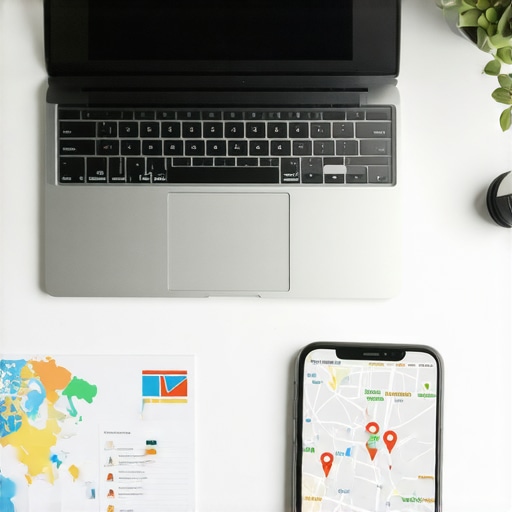How I Discovered the Power of Google Maps Optimization
It all started when I noticed that my local business was barely visible on Google Maps despite having a great product. Frustrated but determined, I dove into the world of Google My Business (GMB) and SEO. Over time, I realized that optimizing my GMB profile could significantly boost my local visibility. Sharing my experience, I want to help others understand what truly works in 2024.
Cracking the Code: My Top Strategies for Google Maps Ranking
Through trial and error, I learned that a well-optimized profile, consistent NAP citations, and engaging customer reviews are essential. I also found that leveraging advanced GMB optimization techniques can make a real difference. Regularly updating photos and posts keeps my listing fresh, which Google favors in its algorithm.
What Are the Hidden Factors That Influence My Map Rankings?
I often wondered about the behind-the-scenes factors affecting my rankings. After researching, I discovered that Google considers local relevance, proximity, and review signals. Interestingly, consistent engagement and responding to reviews can help strengthen my profile’s authority. It’s like building a reputation both online and offline, which Google’s algorithm recognizes.
How Do I Stay Ahead of the Competition Using SEO Support?
Staying ahead isn’t just about quick fixes. I regularly consult authoritative sources like expert GMB support strategies to refine my approach. Outsourcing some of the SEO support has also allowed me to focus on delivering excellent customer service, which naturally boosts reviews and local rankings.
If you’re serious about improving your Google Maps visibility, I encourage you to explore comprehensive guides and stay updated with the latest algorithm changes. Sharing your experiences or questions in the comments can also foster valuable insights. Remember, persistence and strategic optimization are key to ranking high in local search results!
Harnessing Local Relevance: The Unsung Hero of Map Rankings
One of the most nuanced yet impactful factors in Google Maps ranking is local relevance. This means ensuring your business details, categories, and keywords are perfectly aligned with what potential customers are searching for. For example, if you run a bakery in Brooklyn, your profile should highlight keywords like “Brooklyn bakery,” “fresh bread Brooklyn,” and similar local terms. Incorporating these keywords naturally into your business description and services can significantly improve your visibility.
How Can Consistent Engagement Transform Your Map Presence?
Engagement isn’t just about accumulating reviews; it’s about actively fostering a vibrant community around your listing. Responding to reviews, answering questions, and posting regular updates signal to Google that your profile is active and trustworthy. A recent study emphasizes that businesses that reply to reviews see higher rankings and better customer trust. Moreover, engagement encourages customers to leave positive reviews, which are vital for local SEO success. For further insights, check out this comprehensive guide.
What Are the Practical Steps to Optimize Photos and Posts for Maximum Impact?
Visual content plays a pivotal role in capturing attention and boosting rankings. Regularly updating your photos with high-quality images of your products, storefront, or team humanizes your brand and encourages clicks. Posts about promotions, events, or new offerings keep your listing fresh, signaling activity to Google. Remember, the key is consistency—posting weekly or bi-weekly ensures your profile remains active and relevant. To get the most from your visuals, consider using professional photography and descriptive captions infused with local keywords.
Can Advanced SEO Support Help You Outrank Competitors?
Absolutely. Outsourcing specialized SEO support can provide you with tailored strategies that align with the latest algorithm updates. Expert GMB support helps identify hidden opportunities, optimize your profile comprehensively, and implement technical enhancements that often go unnoticed. For instance, integrating schema markup or leveraging local backlink strategies can elevate your profile above competitors. Trusted resources like this advanced support guide offer actionable tactics to ensure your business stays ahead.
If you’re eager to refine your approach, I recommend exploring the latest tools and techniques that can make your profile more authoritative and appealing to both Google and customers alike. Sharing your successes or challenges in the comments can foster a community of continuous learning and growth. Remember, consistent effort and expert guidance are your best allies in dominating local search results!
As I delved deeper into the world of Google Maps SEO, I realized that mastering the basics is just the beginning. True success often hinges on understanding the subtle, nuanced factors that influence rankings. For example, beyond just optimizing your profile and gathering reviews, paying attention to local relevance—such as aligning your keywords with the specific search intent of your local audience—can dramatically enhance visibility. Incorporating local keywords naturally into your business descriptions and service lists creates a more authentic connection with potential customers and signals relevance to Google.
One of the more overlooked yet impactful tactics I experimented with was geotagging photos and leveraging innovative SEO techniques. This involves embedding location data into images and content, which can boost your profile’s relevance in hyper-local searches. It’s akin to telling Google, “Hey, this is exactly where I am, and I serve this community.” The more signals you provide about your local presence, the better Google understands your business’s exact niche.
Reflecting on my journey, I’ve come to appreciate that engagement isn’t merely a numbers game. Responding thoughtfully to reviews, especially negative ones, can turn a dissatisfied customer into a loyal advocate. Google’s algorithm seems to favor profiles that demonstrate active, genuine engagement—making your profile a dynamic reflection of your business’s personality. This also builds trust with potential customers who read those reviews, seeing that you genuinely care about their experience.
But what about the more advanced support tactics? I found that outsource support to experts can offer an edge in highly competitive markets. These specialists use schema markup, local backlinking, and other technical enhancements that often go unnoticed by DIY efforts. Implementing these strategies requires a nuanced understanding of Google’s evolving algorithm, which is why continuous learning and strategic support are essential.
For those eager to push their maps rankings further, I recommend exploring this resource to understand how expert support can be tailored to your unique business needs. It’s not just about quick wins but building a sustainable, authoritative presence that Google recognizes and rewards over time.
Have you experimented with more sophisticated SEO tactics for your Google Maps listing? I’d love to hear your stories and insights. Sharing these experiences fosters a community where we can learn from each other’s successes and challenges. Remember, the journey to local SEO mastery is ongoing—staying curious and adaptive is key.
Unlocking the Secrets of Local Relevance with Technical Precision
As I delved deeper into the intricacies of Google Maps SEO, I realized that beyond basic optimization, harnessing the power of structured data and schema markup can exponentially enhance your local relevance. Embedding schema related to your business category, services, and geographic location helps Google better understand your offerings, which in turn boosts your rankings. I recommend exploring advanced support tactics to implement these technical enhancements effectively.
Leveraging Geotagging and Content Localization for Hyper-Local Dominance
Another nuanced strategy involves geotagging your images and content. By embedding precise location data into your visuals and descriptions, you send clear signals to Google about your physical presence. This technique is especially effective in densely populated areas where local searches are competitive. I found that combining geotagging with localized keywords in your Google My Business posts can significantly improve your visibility in niche neighborhoods or districts.
Engaging with the Community Through Active Review Management
Active review management transcends simple responses; it’s about cultivating a community around your profile. I’ve experimented with personalized responses that acknowledge customer feedback and highlight your unique value proposition. Responding to negative reviews with empathy and solutions demonstrates genuine engagement, which Google’s algorithm favors. For an in-depth guide, I suggest visiting this comprehensive resource. This approach not only improves rankings but also nurtures long-term customer loyalty.
Harnessing Data Analytics to Fine-Tune Your Strategy
In my pursuit of mastery, I’ve come to rely heavily on Google My Business Insights and other analytics tools to decipher what’s working and what’s not. By analyzing customer search queries, engagement metrics, and conversion data, I can tailor my content and optimization tactics with surgical precision. This data-driven approach ensures that every effort aligns with actual user behavior, maximizing ROI. For those interested, I recommend exploring this strategic guide.
Engage and Elevate: Building a Resilient Local SEO Ecosystem
Ultimately, the most successful local SEO strategies are those that evolve continuously. I make it a point to stay updated with industry trends, algorithm updates, and emerging tools. Participating in forums, attending webinars, and collaborating with SEO professionals have enriched my understanding and execution. If you’re committed to elevating your Google Maps presence, I encourage you to share your experiences or questions. Let’s build a community of learners and doers, pushing the boundaries of what’s possible in local SEO.
Things I Wish I Knew Earlier (or You Might Find Surprising)
Relevance Over Rank
One of the biggest revelations for me was realizing that Google prioritizes relevance over sheer volume of reviews or citations. Early on, I focused heavily on gathering reviews, but I found that aligning my business details with local keywords had a more profound impact. It’s like telling Google, “Hey, this is exactly what my community needs,” and suddenly my visibility improved dramatically.
The Power of Geotagging
I underestimated how much geotagging photos could boost my profile. Embedding precise location data into images and posts created a stronger connection with hyper-local searches. It’s a small detail that made a noticeable difference in my rankings, especially in competitive neighborhoods.
Engagement Matters More Than You Think
Responding to reviews isn’t just good manners; it’s a ranking booster. I started replying thoughtfully to every review, positive or negative, and saw my profile’s trustworthiness and rankings improve. Google seems to reward active, genuine engagement, which also builds customer loyalty.
Technical SEO Is Still Key
Using schema markup and other technical SEO tactics didn’t seem necessary at first, but integrating them into my profile made my listing more authoritative. It’s like giving Google a clear map of my services and location, helping it serve my profile to the right audience.
Consistent Updates Keep You Ahead
Regularly posting fresh photos and updates kept my listing lively and relevant. I learned that staying active signals to Google that my business is thriving and trustworthy. A simple weekly post or photo update can be enough to stay ahead of competitors who neglect this.
Resources I’ve Come to Trust Over Time
- Google’s Official Help Center: Their guides on GMB optimization are the most reliable source I’ve found, providing up-to-date best practices.
- Moz Local Search Guides: Moz’s resources helped me understand the importance of local relevance and citation consistency.
- BrightLocal Blog: Their case studies and expert insights offered practical tips that I could implement immediately.
- Neil Patel’s SEO Blog: Neil’s advice on local SEO strategies helped me understand complex concepts in simple terms.
Parting Thoughts from My Perspective
Mastering Google Maps SEO in 2024 is less about quick tricks and more about understanding the subtle signals that Google values—relevance, engagement, and technical precision. The journey taught me that consistent effort, genuine community interaction, and technical savvy go hand in hand. If you’re serious about elevating your local presence, dive into these strategies, stay curious, and don’t be afraid to experiment. And hey, if this resonated with you, I’d love to hear your thoughts or experiences. Sharing our stories helps us all grow and succeed in the ever-evolving world of local SEO.

